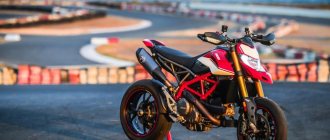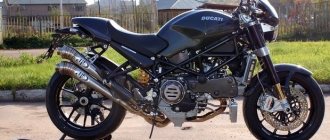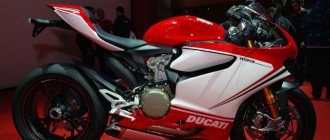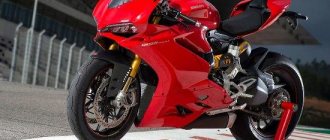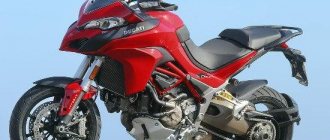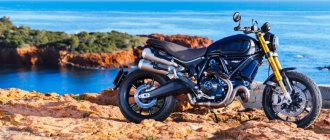Review of Ducati Hypermotard 1100 and 1100S
With the Hypermotard 1100, Ducati has set the bar high for Sumermoto motorcycles. Why is he so wonderful? Let's try to figure it out. While still a concept, the Ducati Hypermotard received the title of The Best of Show at the Milan Salon, not least for its excellent, truly Italian design. Although, of course, appearance is still not the main thing for a motard. And what? Of course, controllability. And the Hypermotard 1100 is doing just fine with it. Large and quite heavy (179kg) by conventional motard standards, the Ducati is incredibly responsive and stable on the move, even despite its high center of gravity. The excellent chassis, which is based on a rigid spatial tubular frame, is ideally combined with a powerful and torquey engine. The two-cylinder L-shaped unit with a volume of 1078 cm3 develops 90 hp. and produces a maximum torque of 102.9 Nm already at 4750 rpm. This traction reserve provides excellent throttle response and makes it possible to effectively accelerate out of corners. The transmission uses a dry multi-plate clutch, like on the Ducati 1098, and the huge torque is processed through a six-speed gearbox. As a result, the Ducati Hypermotard with such a power unit is capable of accelerating to an unusually high speed for motards - over 200 km/h.
The envy of everyone
Even another sportbike can envy such a chassis as that of the Hypermotard 1100: they did not skimp on components - in the front there is a 50 mm fully adjustable inverted Marzocchi fork; in the rear there is a swingarm with a cantilever wheel mount and a Sachs monoshock absorber, which has a progressive characteristic and a full range of adjustments. Openwork and very light Marchesini wheels are shod with Bridge stone sports tires. Braking is handled by Brembo mechanisms - front four-piston with 305 mm discs and rear with two pistons and a disc with a diameter of 245 mm.
Instead of the standard edition, you can install a tuned one from the list of options.
The ergonomics of the pilot's seating position on the Hypermotard 1100 have been carefully designed. As a result, the developers managed to achieve both convenience and reliable control over the motorcycle both in a sitting position and while standing on the pegs. At the same time, the bike with a wheelbase of 1455 mm precisely follows all the rider’s commands, although at first glance it seems rather high and unstable. However, this impression disappears as soon as you move away - already at low speed the Hypermotard acquires excellent stability.
The devices are made in the MotoGP style and are capable of not only displaying, but also accumulating information about technical parameters and lap times for subsequent analysis. Folding mirrors are an extension of the protection of the steering wheel grips.
Among the interesting features of the Ducati Hypermotard, folding mirrors should be noted, which serve as a continuation of the protection covering the handlebars. In addition, the motard is equipped with racing-style instruments and it is possible to download data on the course of a racing session into a computer for subsequent analysis and comparison, including recording of many parameters - from the time of rotation to the gear engaged at each moment and engine speed. However, for this you need to purchase special software and a USB card to transfer data to your computer. This kit is included in the list of options, which also contains many tuning components, such as a sports exhaust system and an air filter.
Factory tuning
In general, turning the Nuper-motard 1100 from a road bike into a sports bike is not difficult. In addition, in addition to the regular version, there is also a Ducati Hypermotard 1100 S - “tuned” already on the assembly line. The main differences of the “esque”: low-friction coating of the front fork, Ohlins backpack-type rear shock absorber (with a remote reservoir), Brembo Monobloc front brakes with radial mount, forged wheels and Pirelli Diablo Corsa III tires. It turns out that Ducati has practically made a racing bike that is ready to ride on public roads. And it is not just adapted for this, but really convenient for everyday use.
| Model | Ducati Hypermotard 1100/1100 S |
| engine's type | four-stroke |
| Engine capacity. cm3 | 1078 |
| Power, hp | 90 at 7750 rpm |
| Transmission | 6-st. |
| Wheelbase, mm | 1455 |
| Seat height, mm | 845 |
| Dry weight, kg | 179/177 |
Video of Ducati Hypermotard 2008 1100 and 1100s:
Hyperactivity
Playfully go beyond 200 km/h, touch the asphalt on the track with your knee and, mischievously, dash through curbs, bushes and holes. These are the main dreams of the modern advanced motorcyclist. When buying a Ducati, you are buying a sportbike. The shell is secondary!
In terms of speed, handling and aggressive riding, Ducati has long been a leader. But you won’t be satisfied with sportbikes alone. Variety is beneficial in offerings to the god of speed.
The number one Italian motorcycle manufacturer in modern history has already achieved some success in introducing off-road instincts into racing genetics. It was in 2003 when the whole world learned what the Ducati Multistrada was. The motorcycle largely saved the company, revived the popularity of the brand and dragged a large number of recruits into the Ducatisti army by the scruff of the neck.
The successful idea, although on a much smaller scale, was pulled off again with the release of the Ducati Hypermotard. It is difficult to say for sure what this model is. Some people see it as a shrunken “Multistrad”, others see it as a crazed “Monster”. Be that as it may, positioning the Hypermotard as a civilian supermoto makes little to no sense. The combination of a moderately powerful large-caliber twin engine with an almost racing “sharp” chassis makes us think that this is a sportbike again. The engineers at Borgo Panigale tried their best to hide it behind long-legged pendants and extraordinary looks. It almost happened...
First generation 1100/1100 S
(2007–2009)
The first prototype was shown back in 2005. The serial Hypermotard was presented in 2007 at an exhibition in Milan. And in two versions at once - basic and “advanced”. “Equipped” is a good word to describe the regular Hypermotard 1100. 1078 cc Desmodue DS engine (two spark plugs and two valves per cylinder, dry clutch) already familiar from the Multistrada 1100 model 2007–2009. mounted in a tubular birdcage frame made of chrome-molybdenum steel. The voluminous front part with a large number of amplifiers carries the steering column and the front “ear” of the engine mount, as well as brackets for the gas tank (it should be noted that the tank is small - only 12.4 liters). At the rear of the frame is the rear "ear", the mounting point for the swingarm and the lugs to which the rear subframe is bolted. The engine in this design performs load-bearing functions. The suspensions in everything, except for the travel and length of the fork stays, are identical to their closest neighbors in the model line. A 50mm Marzocchi “upside-down” shock absorber is installed at the front, and a Sachs monoshock absorber at the rear. The steering column angle of 24°, which is not compatible with the relaxed driving mode, creates for the driver the same feeling when the calipers on the front wheel (radial, but not monoblock Brembo on 305 mm discs) can be seen by tilting the head down, and without a headlight. problems to reach with your palm. The seat is quite long, although narrow. Passenger footrests are available, but checking their functionality is a below-average pleasure. Hypermotard is a motorcycle for the egoist.
The most appropriate word to describe the Hypermotard in the S version is “armed.” Limited versions of Ducati are usually painted in a special way and stuffed with the most modern components available on the market. In the case of the Hypermotard 1100 S, these are Marzocchi inverted telescopic forks with titanium nitride coating (black feathers), a fully adjustable Ohlins monoshock, Brembo monobloc radial calipers on the front wheel, Marchesini Forged forged wheels and a number of carbon parts instead of plastic.
The motorcycle, regardless of the version, looks completely unconventional. It's all because of the recognized genius of maestro Pierre Terblanche! It should be noted that, despite a large number of common parts with the Multistrada, the Hypermotard project was created from scratch.
There is very little plastic. Like the torn clothes of a pumped-up bodybuilder, it reveals muscles, in this particular case represented by a damn beautiful engine and an intricacy of pipes located mainly under the tail of the exhaust system. Everything is on display! The front part is interestingly designed. Above the wheel rises an impressively sized beak with fake nostrils-air intakes. In this case, the front fender is a small plastic element that is screwed through long spacers onto the front caliper brackets. Mirrors that fold out to the sides of the steering wheel grips are both a triumph for designers and a nightmare for owners. It’s very easy to leave them hanging on a fence or thinly spread them on the asphalt, but ordering new ones to replace broken ones is very difficult and expensive. Fans of quickly clearing traffic jams install mirrors on the steering wheel or turn their heads like an owl. Of course, one cannot fail to note the unreal beauty of the wheels. Especially the rear one, which is specially exposed due to the use of a cantilever pendulum.
Second generation 1100 EVO /1100 EVO
SP /796 (2010–2012)
Since 2010, Ducati’s beloved manipulation of installing increasingly more powerful engines in the same chassis has entered a new stage. This time it came to Desmodue Evoluzione. The updated forced 1078 cc twin with two valves and one spark plug per cylinder added agility to the Hypermotard. To be precise, an additional 5 liters were gained at the peak. With. This power plant is visually easily identified by its noticeably larger oil cooling radiator. For more accurate operation of the injection system, two lambda probes are installed on motorcycles of the second and all subsequent generations. With the change of generations, in order to reduce weight, the birdcage frame got rid of forged elements.
There is no S version for the Hypermotard 1100 EVO, but there is an EVO SP version, which is essentially the same thing. Distinctive features of the Hypermotard 1100 EVO SP are forged Marchesini Forged wheels, carbon fiber in the tail and protective drive belt covers, Ducati Data Analyzer data logger, a less radical fork angle, Brembo M4 monoblock calipers from the 1098 sportbike and flashy coloring.
For those who have decided on a model, but do not have the necessary skills or are simply aiming for a less violent engine, from 2010 to 2012, along with “liters”, the Ducati Hypermotard 796 was produced. The differences from its more cubic capacity counterparts are only in the displacement of the L-twin Desmodue ( 803 cm3, 81 hp at 8000 rpm and 75.5 Nm at 6250 rpm), electronic settings, lowered saddle (height only 825 mm), less flashy paint and dry weight (167 kg). Moreover, 803 cm3 is not just an enlarged “double-barreled gun” from the Monster 796, but, in fact, a new power unit. According to statements, the engine in city mode consumes only 5 liters per 100 km.
Third generation 821/821
SP / Hyperstrada /937 (2013 – present)
At a time when the original incarnation of the “Hypermotard” had already outlived its usefulness, the idea received a completely logical continuation. In November 2012, at the EICMA home exhibition, the Italians proudly presented two hypermotorcycles at once - the Ducati Hypermotard 821 and its touring continuation, the Ducati Hyperstrada 821. The new generation inherited the idea of the previous one, but at the level of visual images the motorcycles are completely different. The 821st replaced aggression with law-abiding behavior. The number of smooth lines has noticeably increased, and there is more plastic on the tail and sides. The rear of the motorcycle has noticeably shrunk in volume thanks to the relocation of the exhaust system “can” to the right side, near the rear wheel. The rear-view mirrors have been moved from the ends of the steering wheel to separate stands behind the consoles. At the same time, the protective “bugs” with integrated direction indicators remained in their rightful place.
The engine has jumped a generation again. Inside the once again reduced birdcage is the second generation Testastretta 11° L-twin with a displacement of 821 cm3 (110 hp at 9250 rpm, 89 Nm at 7750 rpm), one spark plug and four valves on cylinder, Ride-by-wire system, liquid cooling and wet clutch with booster. In the clutch control system, the hydraulic drive was replaced by a cable drive. The rear subframe is made of two aluminum castings, between which a plastic section is installed. The on-board set of safety systems standardly installed on all modifications bears the common name Ducati Safety Pack. This includes three-level ABS, eight-level traction control and three options for power characteristics, where each level corresponds to individual settings for safety systems. All electronics are built exclusively on Italian Magneti Marelli components and are controlled from a large LCD instrument panel! Due to the modernized frame and compacted layout, it was possible to squeeze a 16-liter fuel tank into the third generation motorcycles.
The chassis has undergone a number of fundamental changes. The basic Ducati Hypermotard 821 is equipped with a Kayaba upside-down shock absorber with a 43 mm diameter of stays (170 mm wheel travel) and a Sachs monoshock absorber (150 mm wheel travel) with damping and preload adjustments. The wheel size remains unchanged throughout the entire period of development of the family - 120/70–17 front and 180/55–17 rear.
The Ducati Hypermotard SP, as before, is a slightly more sport-oriented special version. Distinctive features are a fully adjustable 50 mm Marzocchi “upside-down” with a less “sharp” slope, an Ohlins monoshock absorber also with all possible adjustments, Marchesini Forged wheels, a lightweight aluminum steering wheel, more powerful Brembo radials, carbon parts in the lining and the Riding Modes system from 1199 Panigale with Race/Sport/Wet modes (on the base model Sport/Touring/Urban).
You and I will never understand the tourism that the Italians imagined when completing the Hyperstrada model. An action-packed promenade along a picturesque mountain serpentine with roads that look like a velor carpet is far from the same as a trip with a bunch of luggage from Moscow somewhere to Kostroma. For Russia, Hyperstrada 821 is not a tourist! The Strada differs from the Motard only at the level of relatively easily replaceable parts and electronics. The motor, frame and some of the plastic are unchanged. Distinctive features of the Hyperstrada are an inverted Kayaba 43 mm fork (wheel travel reduced to 130 mm), a Sachs monoshock absorber with adjustment on the right side (wheel travel reduced to 130 mm), a full front fender rather than a short fender liner, a long rear hugger, the presence center stand, thicker seat cushion (saddle height 830 mm), brackets for side cases, high windshield, passenger handles, plastic crankcase protection, luggage rack, higher handlebar brackets, two 12 V sockets and a more powerful generator.
The changes that occurred to the Hyperstrada/Hypermotard family in the 2016 model year should not be considered as a separate generation. Both motorcycles received a slightly larger engine (937 cm3 Testastretta 11° - 113 hp and 97.9 Nm) with an additional oil cooler and an enlarged exhaust system. Exterior transformations are limited only to the LED turn indicators in the guards on the steering wheel. As before, the Ducati Safety Pack is part of the standard equipment. The instrument panel received a more advanced LCD display with an indicator of the gear engaged.
The special versions of Hyperstrada and Hypermotard SP with 937 cm3 engines, in the context of differences in equipment, exactly repeat the previous situation. There is just one small addition - magnesium cylinder head covers on the Hypermotard SP.
Technical features
To begin with, we should not forget that this is a full-size motorcycle in a body that tends to the shape of a cross-country motorcycle. With the apparent accessibility of all components and assemblies, Hypermotard is one of the main characters in the nightmares that mechanics have. The third generation motorcycles are particularly dense in their layout. It seems like everything is in plain sight, but it’s extremely difficult to get anywhere. To access the air filter, you have to remove most of the wiring and completely remove the fuel tank. But it is very easy to access the battery. It is located immediately under the seat. The spark plugs of the third generation Hypers cannot simply be changed. To remove the rear one, you need to lift the tank, after first disassembling half of the wiring. To get the front spark plug, you will have to remove the cooling radiator. The air filter, like earlier motorcycles, is located under the gas tank. It would seem that access to the drive belts is open, but everything is not so simple. There is minimal free space around the entire drive mechanism. In order to replace or service anything without partial disassembly, you need to be the owner of the microscopic palms of a starving first-grader! And so it is everywhere. Servicing first and second generation motorcycles is a little easier. The fasteners are extremely fragile everywhere (especially in the third generation). Numerous pistons and ties break in your hands. Even among professionals in their field, they are considered consumables.
In general, the idea of servicing Hypermotard on your own is doomed to failure. At best, you will break a lot of small parts. At worst, you will damage large parts or immobilize the motorcycle.
Hypers, like any other motorcycle with large twins, have special requirements for maintaining the final drive chain. It is important to carefully monitor the tension level. A strong pulsation from a “double-barreled shotgun” in the presence of excessive slack will very quickly stretch the chain to critical values, and will also finish off the stars.
Models with a dry clutch should not be afraid. When properly maintained, it is only slightly noisier than its liquid counterparts. The “bucket of bolts” sound is formed only when there is significant wear on the teeth with which the drive discs transmit force from the basket. Loud noise and clanging are an indicator of imminent death. It is better not to bring the clutch to this state. The average mileage between replacements is from 10,000 km to 15,000 km (it all depends on the driving style). The manufacturer recommends adjusting the valve desmodrive and replacing drive belts every 12,000 km. After 2012, this interval was increased to 24,000 km. It is best to entrust such work to professionals!
The L-shaped motor is reliable and relatively unpretentious. The main condition for its trouble-free operation is the proper oil level and timely maintenance. Water-powered Ducatis do not like underheating - the spark plug in the rear cylinder floods almost immediately. The engine stops igniting the mixture correctly, sneezes loudly, kicks, and thereby destroys the overrunning clutch during subsequent starts. The Ducatist is obliged to monitor the condition of the spark plugs and change them in a timely manner! In the case of Hypermotard, it’s better not to do it yourself!
The situation with spare parts is very, very difficult. Everything new is astronomically expensive; used parts that still retain their service life are extremely rare. Hypermotard, in principle, is not the most common motorcycle in Russia!
It’s paradoxical, but true – stunt riding is contraindicated for the entire Hyperstrada/Hypermotard family without appropriate modifications. And especially in the professional format, when the angles approach extremes. The oil pick-up is located exactly in the middle of the engine, lifting angles on the verge of the balance point and further to 90° are guaranteed to lead to serious oil starvation. Both cylinders are at risk, who gets it first. More often the liners of the “horizontal” cylinder lift up. In any case, slight hooliganism may well lead to serious problems. Engine repair is extremely expensive! It is possible to partially protect the engine from destruction. To do this, you need to move the oil intake lower and add oil above the level.
Third generation motorcycles have some complaints about the engine. Almost everywhere, oil seeps through the O-rings and up the studs that hold the cylinders. Such tiny leaks do not affect the lubrication system, but have a negative impact on aesthetics. It’s not good for a thoroughbred Italian motorcycle to have oil leaks at the junction of the heads and cylinders! The leak is eliminated by replacing the O-rings.
The third generation is also characterized by a problem with the failure of lambda probes. High-quality Russian gasoline does not always do its unpleasant job. After refueling with “scorched” fuel, the dashboard almost immediately reports the death of the lambda probe (an error light comes on). The motorcycle continues to ride as it was driving. There are several solutions - either change the sensor a couple of times a season and reset errors on the service equipment, or uproot the probes once and for all and reflash the control unit.
Speaking about Ducati, one cannot help but touch on tuning issues. Hypermotard and Hyperstrada already sound loud and look menacing out of the factory, but there is no limit to perfection. And here numerous tuning catalogs and third-party manufacturers of iron and carbon come to the rescue, the names of which all decent Ducatists know by heart (Ducati Performance, Termignoni, Rizoma, STM, Ducabike, Light Tech, etc.). The most common tuning is installing a zero-resistance filter and direct-flow exhaust. The motorcycle immediately stops being dull at the start and begins to sound like an angry tiger. Also in use are various kinds of styling and combined assemblies from Hypermotard and Hyperstrada parts.
Crash tests
Ducati Hypermotard/Hyperstrada – this is the case when it’s better not to fall! There are not many parts, but all are expensive and fragile. The first two generations survive serious accidents a little easier due to a stronger frame and slightly thicker plastic.
All Ducati Hyperstrada/Hypermotard have a long Marzocchi front fork that is “hazardous”. Despite the typical filling, feathers of this length are not found anywhere else. Finding a straight, working fork during the process of rebuilding a motorcycle after an accident is a very difficult task. During frontal impacts, the front fender liner mounting brackets often break out. The bolts remain in the fork and have to be carefully drilled out. When landing on the right side, the exhaust is guaranteed to suffer. In the third generation, the lower pump hose is located rather wide on the left side. There is a small chance of damaging it if it falls, thereby leaving the motorcycle without antifreeze.
Conclusion
Real practice shows that the Hypermotard/Hyperstrada family, in the hands of an ordinary motorcyclist, turns into a good and comfortable city motorcycle. There is no trace of track use or pirouettes, which famous champions demonstrate in their proprietary video footage. Disappointments due to the discrepancy between actual and declared capabilities are partly the fault of the driver (you can’t just sit down and fall on your elbow), partly aggressive marketing, and also, as it turned out, some technical limitations built into the design.
However, for an aggressively driving city dweller, Hypers are perhaps the best weapon for street hooliganism. Such a combination of an L-twin with good traction and rich bass in a compact shell with a minimum of plastic parts with a sportbike chassis is practically not found on production vehicles!
For assistance in preparing the material, we would like to thank
Desmoservice Moscow , www.desmoservice.ru , tel. 8-916-087-82-77. Roll, wheel! > May 8, 2016 14:13 Mikhail Pimus
Ducati
The Hypermotard is a motorcycle that combines a powerful engine with a balance of geometry and chassis that results in excellent feedback from the bike to the rider.
The bike is perfect for honing your aggressive riding skills. The first thing to note is the new 1100 Desmo engine. According to Ducati, it is the ideal for Hypermotard. The V-shaped (90 degrees) two-cylinder engine is very light, develops a power of 95 hp. and torque 103 Nm. The motorcycle is also equipped with a six-speed gearbox and fuel injection. The dry weight of the motorcycle does not exceed 172 kg (EVO SP - 171 kg).
All the pleasures of riding a Hypermotard can be shared with a passenger. The ride on lightweight Marchesini wheels with Bridgestone BT015 tires is wonderful. There are two modifications: EVO and EVO SP. The second features a fully adjustable Kayaba 48mm fork instead of a 50mm Marzocchi and an Ohlins monoshock instead of a Sachs.
In 2010, they began installing a new gadget on the 1100 EVO and EVO SP - “Ducati Data Analyzer (DDA)”. This system records all the information of the motorcycle: revolutions, engine temperature, mileage and all that. All data is stored on a USB drive, allowing pilots to then view all this data.
Technical characteristics of Ducati Hypermotard 1100 EVO / EVO SP 2010:
• Engine: L-Twin, 2 valves per cylinder, Desmodromic, air cooled • Displacement: 1078 cm3 • Bore x Stroke: 98 x 71.5 mm • Compression ratio: 11.3:1 • Power: 95 hp. (69.9 kW) 7500 rpm • Torque: 103 Nm at 5750 rpm • Fuel system: Siemens injector • Exhaust: 2-1-2 • Gearbox: 6 speed • Ratio: 1=37/15, 2= 30/17, 3=27/20, 4=24/22, 5=23/24, 6=24/28 • Primary gear: 1.84:1 • Final drive: chain, front sprocket - 15, rear sprocket - 41 • Clutch: Dry multi-plate clutch with hydraulic control • Standard: Euro3 • Frame: Tubular steel trellis • Wheelbase: 1455 mm / 1465 mm • Rake: 24° • Front suspension: Marzocchi 50 mm • Front wheel travel: 165 mm / 195 mm • Front wheel: 5-spoke, 3.50×17 • Front tire: 120/70 ZR17 • Rear suspension: Sachs monoshock. Aluminum single-sided swingarm • Rear wheel travel: 141 mm / 156 mm • Rear wheel: 5-spoke, 5.50×17 • Rear tire: 180/55 ZR17 • Front brake: 2 x 305 mm discs, Brembo 4-piston calipers • Rear brake : 245mm disc, 2-piston caliper • Fuel tank: 12.4 L • Dry weight: 172 kg / 171 kg
Photos of Ducati Hypermotard 1100 EVO 2010
Photos of Ducati Hypermotard 1100 EVO SP 2010
Video of Ducati Hypermotard 1100 EVO / EVO SP 2010
The boundaries of genres in the motorcycle world are gradually becoming blurred, motorcycles of different classes are becoming similar to each other, but one absolute fact is encouraging: the number of new motorcycles is steadily growing and we have plenty to choose from.
Take for example the new Hypermotard 1100 S from Ducati. It’s just a Frankenbike, if you can call it that, a motorcycle that, while combining all the features of a superbike, has the charm of a real 450 cc super-moto. The name of the new motorcycle, Hypermotard 1100S, perfectly emphasizes its main qualities.
Just a few years ago, none of the leading manufacturers would have dared to introduce such a motorcycle on the market. But already in 2008 we will have not only the new Ducati, but also the 950 SM from KTM, the Lightning XB12STT from Buell, as well as the HP2 Megamoto from BMW. The appearance of such motorcycles proves that manufacturers tacitly recognize the existence of a new class, which can be conventionally designated as a “moto-hybrid”. What once seemed like an innovation is now firmly established in the market.
Although the Hypermotard 1100 S is somewhat similar to its predecessor, the Singles, also a supermotard style motorcycle, designer Pierre Terblanche knew that he needed to give it a slightly different look and give the new motorcycle features that would significantly distinguish it from the Singles. We already know that a “supermotard” is a tough motorcycle that does not forgive mistakes. It will carry you over the bumps on the hardest roads, overtaking any sportbikes along the way, but what will you do the rest of the time when the road levels out and becomes smooth as a mirror? The standard Hypermotard and the new test Hypermotard 1100 S class will answer this question.
Once you settle into the tall 86cm saddle, it will feel too narrow at first. And looking ahead, you will not immediately understand “where everything went.” The dashboard has become the size of an i-Pod, and the tiny windshield barely accommodates the minimum size headlight allowed by the Road Traffic Regulations.
The saddle tapers at the front, allowing the rider to feel comfortable. Although the Hypermotard's chassis is almost identical to that of the almighty Multistrada, the rider position is more radical, practically hanging over the front of the bike. But this is even great! Your hands naturally rest on the elegant black steering wheel, which is 91 cm wide. The footrest is positioned perfectly, it is made in such a way that your legs will not become numb during a long ride: special rubber inserts protect the rider’s legs from vibrations. The saddle is certainly not plush, but it will prevent your butt from going numb twenty minutes into the ride when there are still several hours of riding ahead.
I won't say that you will be able to enjoy long trips at high speed. You drive a little longer at speeds over 100, and you pay for it with severe fatigue in your neck. Due to the fact that the fairing is too small, the rider is literally “open to all winds.”
Some of the handling features of this motorcycle also caused a lot of controversy. Although, you should trust the experience of Ducati, which has a well-known consistency in producing well-handling motorcycles. With its 146.8 cm, the wheelbase seems quite long compared to the typical sportsbike wheelbase dimensions, which do not exceed 137 – 139 cm. As a result, the Hypermotard 1100 S is both maneuverable and stable. However, it's a little sluggish when cornering too tight and requires more input than usual on the steering wheel. The Hypermotard feels a little too slow on the first corner, but once you get used to leaning forward a little and increasing the pressure on the steering wheel, everything falls into place. This is certainly helped by the lightweight Marchesini aluminum wheels, which are 2 kg lighter than those fitted to the previous model.
Based on this, we can conclude that the Hypermotard is designed for a more aggressive riding style than a regular sportbike. With it you need to rush into the turn on the brakes, leaning smoothly, in a cross-country style, and not forgetting to put your weight on the steering wheel. If you ride it like a huge motard, the Ducati is flawless. Well, if you are a little lazy, he will do everything as it should, perhaps without much zeal.
The main thing you need to get used to when switching from a sportbike to the new Hypermotard is its long suspension. In stock setup it provides a fairly soft ride, but will need to be firmed up a bit for canyon racing. Otherwise, the bike will start to bounce around a lot as the weight shifts forward on the brakes and back again while the throttle is open. By pre-loading the fork, you will make the motorcycle more predictable when cornering and you will have more confidence in the saddle.
The 50mm Marzocchi fork and Öhlins shock absorber performed well on the bumps of the rather challenging test trails. The ultra-durable Hypermotard handled the toughest bits of asphalt without breaking a sweat.
And now a few words about the front brakes. When Ducati was asked why they decided to install dual radial calipers and 305mm brake discs on the new motorcycle, then-president Federico Minoli replied that the developers had polled a focus group, and the majority of respondents had these requirements for the brakes. Sorry guys, you misunderstood something. Everything seems fine, and we love big brakes, but those Brembos on the new Hypermotard are killer! The master cylinder and monobloc calipers (with larger discs) are exactly the same as on the 1098S, but they work great on the race track and hold the car at its highest speed, which can reach 278 km/h. And on the Hypermotard, even with smaller discs, braking force comes on so early that braking is almost impossible to modulate. The front wheel even starts to squeal in protest. In our opinion, one disk would be quite enough.
There is no need to complain about the engine. If you haven't yet had the opportunity to test Ducati's twin-valve, twin-spark engine, now is the time. The 1078 cc Twin has increased in diameter from 94 to 98 mm, while the piston stroke remains the same as in the 1000 - 71.5 mm, and the compression ratio has risen by half a point to 10.5:1. In dynamic tests, the engine showed a power of 80 hp. and torque 93.15 N.m. This is about 4 hp. less than the Multistrada 1100 we tested not too long ago. This is due to the fact that the Hypermotard airbox is slightly smaller, but at the same time it creates an additional 2.7 Nm of torque at a peak of 4900 rpm. The only thing this bike lacks is the right power to weight ratio. We estimate that the new Hypermotard weighs 22kg less than the Multistrada.
On the road, the short gear ratio (15/42) allows the Hypermotard to take off easily, and also lifts the front wheel with any slight throttle opening. The engine's torque is such that even on difficult trails, the Hypermotard S can move for a long time in one gear, with a little rumble on the climbs. Peak power is 6500 rpm. The rev limiter comes into play at 8700, so you can experiment a bit with over-torque. This is a fairly “accommodating” and interesting engine.
The fuel injection system is simply excellent. In the past, we have tested an air-cooled Ducati that overheated early in the morning and then crashed until it stopped completely at the most inopportune moment. There are no such problems with this motorcycle.
What needs some work is the gearbox. Overall, shifting is fairly easy, with just a little bounce between gears, but there are a few false neutral points when the transmission suddenly jumps from second gear back to neutral. The clutch is hydraulically operated and feels good, although some prefer a cable clutch which is much easier to adjust. A dry clutch can be quite stiff if you push it too hard when starting, but that's generally not the right driving style. In low gears the torque is already quite decent, so there is no need to scoff at the gearbox.
Many of us are unlikely to appreciate the folding mirrors at the ends of the handlebars of a motorcycle. They provide a fairly wide rear view, but limit it to 123 centimeters vertically. When the mirrors are folded, this distance is reduced by another 30 cm. And with the mirrors open, it is no longer possible to slip between cars in city traffic jams. Using the mirror reinstallation kit available from the Ducati catalogue, you can move them closer to the center and install them on top. They, of course, do not look as cool as in the original position invented by Terblanche, but they are more convenient in traffic.
Another inconvenience of this model is that the fuel tank easily overfills, because it is not possible to look into this black 12-liter container, and when the filling line approaches the top, you do not have time to follow it. In addition, the top of the tank is so flat that it is difficult not to spill gasoline when filling it. So be sure to stock up on a roll of toilet paper so you can clean it every time you refill.
Let's leave this unnecessary criticism aside and finally say that you can simply fall in love with the new Hypermotard. It's not the fastest, it's not the lightest, or even the most maneuverable, but it's clearly above average in all of those categories. The combination of these qualities makes it the most interesting motorcycle out there.
In no way inferior to others. Unusual. Different. It's designed for entertainment.
